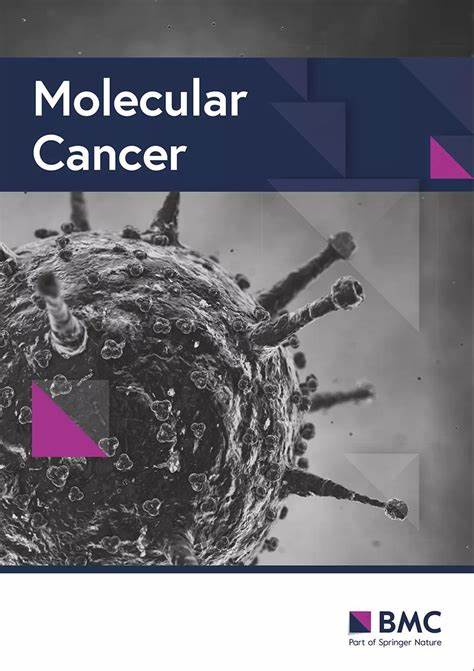Proteogenomic characterization of molecular and cellular targets for treatment-resistant subtypes in locally advanced cervical cancers
IF 27.7
1区 医学
Q1 BIOCHEMISTRY & MOLECULAR BIOLOGY
引用次数: 0
Abstract
We report proteogenomic analysis of locally advanced cervical cancer (LACC). Exome-seq data revealed predominant alterations of keratinization-TP53 regulation and O-glycosylation-TP53 regulation axes in squamous and adeno-LACC, respectively, compared to in early-stage cervical cancer. Integrated clustering of mRNA, protein, and phosphorylation data identified six subtypes (Sub1-6) of LACC among which Sub3, 5, and 6 showed the treatment-resistant nature with poor local recurrence-free survival. Elevated immune and extracellular matrix (ECM) activation mediated by activated stroma (PDGFD and CXCL1high fibroblasts) characterized the immune-hot Sub3 enriched with MUC5AChigh epithelial cells (ECs). Increased epithelial-mesenchymal-transition (EMT) and ECM remodeling characterized the immune-cold squamous Sub5 enriched with PGK1 and CXCL10high ECs. We further demonstrated that CIC mutations could trigger EMT activation by upregulating ETV4, and the elevation of the immune checkpoint PVR and neutrophil-like myeloid-derived suppressive cells (FCN1 and FCGR3Bhigh macrophages) could cause suppression of T-cell activation in Sub5. Increased O-linked glycosylation of mucin characterized adeno-LACC Sub6 enriched with MUC5AChigh ECs. These results provide a battery of somatic mutations, cellular pathways, and cellular players that can be used to predict treatment-resistant LACC subtypes and can serve as potential therapeutic targets for these LACC subtypes.局部晚期宫颈癌治疗耐药亚型分子和细胞靶点的蛋白质基因组学特征
我们报告了局部晚期宫颈癌(LACC)的蛋白质基因组学分析。外显子组测序数据显示,与早期宫颈癌相比,鳞状和腺状lacc中角化- tp53调控轴和o-糖基化- tp53调控轴分别发生了显著改变。mRNA、蛋白和磷酸化数据的综合聚类鉴定出6种LACC亚型(Sub1-6),其中Sub3、5和6表现出耐药性质,局部无复发生存率较差。活化基质(PDGFD和cxcl1高的成纤维细胞)介导的免疫和细胞外基质(ECM)激活升高,表征了富含muc5achi高的上皮细胞(ECs)的免疫热Sub3。上皮-间质转化(EMT)和ECM重塑的增加是富含PGK1和cxcl10高ECs的免疫冷鳞状Sub5的特征。我们进一步证明CIC突变可以通过上调ETV4触发EMT激活,免疫checkpoint PVR和中性粒细胞样髓源性抑制细胞(FCN1和FCGR3Bhigh巨噬细胞)的升高可以抑制Sub5中的t细胞激活。黏液蛋白o-链糖基化的增加表征了富含muc5achhigh ec的腺lacc Sub6。这些结果提供了一系列体细胞突变、细胞通路和细胞参与者,可用于预测治疗耐药的LACC亚型,并可作为这些LACC亚型的潜在治疗靶点。
本文章由计算机程序翻译,如有差异,请以英文原文为准。
求助全文
约1分钟内获得全文
求助全文
来源期刊

Molecular Cancer
医学-生化与分子生物学
CiteScore
54.90
自引率
2.70%
发文量
224
审稿时长
2 months
期刊介绍:
Molecular Cancer is a platform that encourages the exchange of ideas and discoveries in the field of cancer research, particularly focusing on the molecular aspects. Our goal is to facilitate discussions and provide insights into various areas of cancer and related biomedical science. We welcome articles from basic, translational, and clinical research that contribute to the advancement of understanding, prevention, diagnosis, and treatment of cancer.
The scope of topics covered in Molecular Cancer is diverse and inclusive. These include, but are not limited to, cell and tumor biology, angiogenesis, utilizing animal models, understanding metastasis, exploring cancer antigens and the immune response, investigating cellular signaling and molecular biology, examining epidemiology, genetic and molecular profiling of cancer, identifying molecular targets, studying cancer stem cells, exploring DNA damage and repair mechanisms, analyzing cell cycle regulation, investigating apoptosis, exploring molecular virology, and evaluating vaccine and antibody-based cancer therapies.
Molecular Cancer serves as an important platform for sharing exciting discoveries in cancer-related research. It offers an unparalleled opportunity to communicate information to both specialists and the general public. The online presence of Molecular Cancer enables immediate publication of accepted articles and facilitates the presentation of large datasets and supplementary information. This ensures that new research is efficiently and rapidly disseminated to the scientific community.
 求助内容:
求助内容: 应助结果提醒方式:
应助结果提醒方式:


